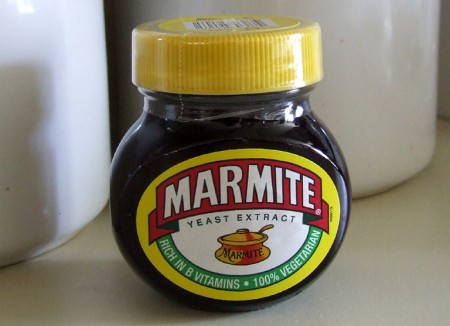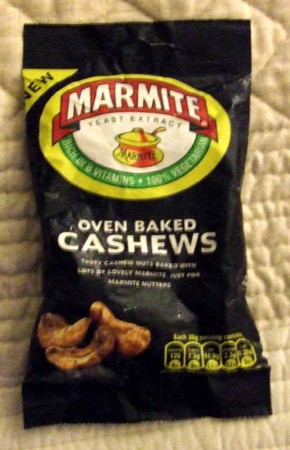United Kingdom
Marmite
Over the years, I have had the pleasure and opportunity to savor unusual food from across the globe. I have enjoyed guinea pig at at a table where the other diners didn’t like the way the entree was looking at them; I have delighted in the rich, buttery taste of the spiky and odiferous durian, while others were gagging in the bushes. To this day people wonder what is my kryptonite, my gastronomic achilles heel. Surely, there is some food-like substance that has the power to ruin my breakfast. Your honor, ladies and gentlemen of the jury, let the record state that for the murder of my taste buds, I find the defendant – Marmite – guilty as charged. I’m sure I am going to catch some flak from some of my British counterparts for this, but this is to be expected. In fact, the official Marmite web site is split into two sections accessed from the home page – one for folks who love it, the other for those who hate it. Hate seems like a harsh term, but it adequately describes those who intensley dislike this crime against nature disguising itself as food. Marmite is a spread for toast that is the by-product of beer production; it is a sludge-like substance made from yeast extract. It has the consistency and stickiness of molasses and the taste of salted crankcase oil from an engine run for 100,000 miles. I don’t really have a point of reference here, never having salted crankcase oil, but I’m willing to bet I’m right.
Marmite has been a breakfast staple in Her Majesty’s realm since 1902, originally sold in earthenware jars (presumably to keep the evil at bay). Because the source is the same, it is similar to the famous Australian Vegemite (thank you, Men at Work) but with a unique taste (since the manufacturing process is slightly different). When mentioning to my friends in the UK that I have tried Marmite for breakfast I am greeted with either a “Dear God in Heaven, why?” or “Heavenly – I love it!” The conflict between love and hatred of the spread has even prompted a classic commercial for the product that perfectly demonstrates the two sides; I will only say that it needs to be seen to be appreciated. As with any allegedly edible substance, I have given it the old college try numerous times. My first encounter with uni (sea urchin) was less than desirable, but it turns out that sampling sushi in Michigan for the first time may not be the best approach – a second attempt in California was enough to win me over. Sadly, I have tried Marmite approximately 5 times now, each with the same result. Since the traditional application is to slather the goo on toast, I’ve even tried it with artisan breads hoping to improve the experience – ever seen a loaf of bread commit suicide? At each sitting I completely eat the slice of toast, hoping that some subtle undertones or mysterious aftertastes come into play, but the result is always the same. The heady aroma of fermented yeast, paired with the saltiness and glue-like consistency always results in something like an episode of FOX TV’s “When Breakfast Foods Attack”. A freind had sent me a bag of Marmite cashews – roasted cashews lightly coated in Marmite – but for some odd reason the taste was not overwhelming and I was able to finish the bag.
Whenever I am sampling something for the first time, whether with family members or friends out dining, I always impart the same advice – do not say it’s disgusting until you try it. Have a nibble, a sip, and if you don’t like it, you’ll never have to eat it again. I do not wish to discourage anyone from trying new and unusual foods, and my opinion is just that. To those of you traveling to (or living in) the UK, I advise you to at least try some at breakfast and decide for yourself, but I strongly caution against the investment of a large jar should you decide to make a trip to the market. Personally, I believe in the manifestation of evil on Earth, and for me, Marmite is proof of that.
Marmite
Available at most UK groceries and import stores in the US





Your article on Marmite was awsome! As a fellow gastropod I must confess that to me Marmite is heaven on earth and I couldn’t live without it! As they say, you either love it or hate it and I LOVE IT. It’s a very versatile ingredient. For example, ‘Marmite Vinaigrette’ and ‘Boston Baked Beans’. These, amongst a host of other recipes, can be found in the holy bible of Marmite entitled ‘The Marmite Cookbook’ by Paul Hartley (Publisher is Absolute Press 2003. E-mail [email protected]. ISBN: 1 904573096). With greetings from the UK. Hazel, alias Marmite Lover.
Hazel, I still have a jar of Marmite that will most likely last a very long time, so I’ll have to give one or more of the recipes a try. I just returned from Boston and will cover Boston Baked Beans – perhaps I can try the Marmite variety at the same time. Thanks for your comments!
Of all the food I have tried with Val this has to be the worst. The cashews were decent but pure Marmite has +1 on Pure Evil.
Your toast should be buttered first and then the Marmite spread sparingly on top of that! 🙂 Cheese on toast with a little Marmite is also delicious! My husband loves twiglets which taste Marmity but he hates Marmite itself. The Marmite cookbook is fab, I need to dig it out now, Hazel has inspired me! 🙂
I suppose to be fair I need to try it enhanced (with something else besides unadulterated toast). I’m a little put off by the saltiness, but it might work in a recipe where you might use soy sauce – braised Marmite pork belly, anyone?